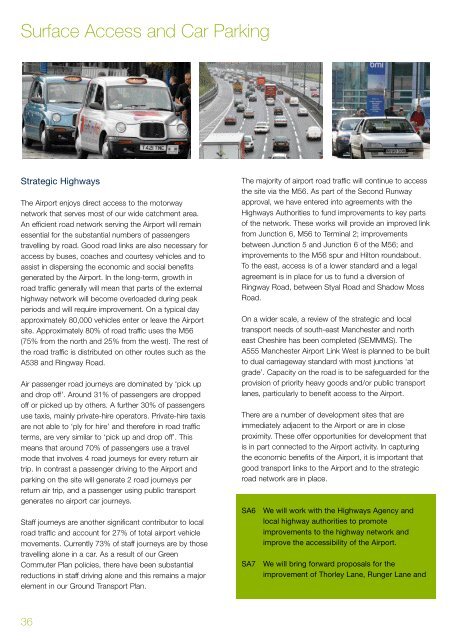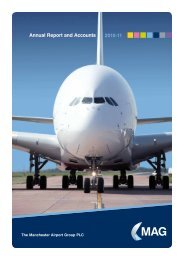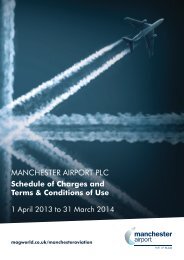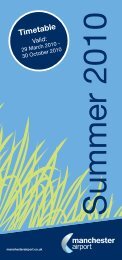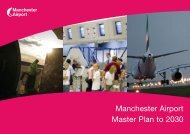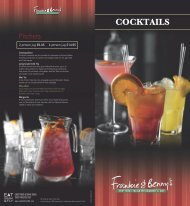Land use plan - Manchester Airport
Land use plan - Manchester Airport
Land use plan - Manchester Airport
You also want an ePaper? Increase the reach of your titles
YUMPU automatically turns print PDFs into web optimized ePapers that Google loves.
Surface Access and Car Parking<br />
Strategic Highways<br />
The <strong>Airport</strong> enjoys direct access to the motorway<br />
network that serves most of our wide catchment area.<br />
An efficient road network serving the <strong>Airport</strong> will remain<br />
essential for the substantial numbers of passengers<br />
travelling by road. Good road links are also necessary for<br />
access by b<strong>use</strong>s, coaches and courtesy vehicles and to<br />
assist in dispersing the economic and social benefits<br />
generated by the <strong>Airport</strong>. In the long-term, growth in<br />
road traffic generally will mean that parts of the external<br />
highway network will become overloaded during peak<br />
periods and will require improvement. On a typical day<br />
approximately 80,000 vehicles enter or leave the <strong>Airport</strong><br />
site. Approximately 80% of road traffic <strong>use</strong>s the M56<br />
(75% from the north and 25% from the west). The rest of<br />
the road traffic is distributed on other routes such as the<br />
A538 and Ringway Road.<br />
Air passenger road journeys are dominated by ‘pick up<br />
and drop off’. Around 31% of passengers are dropped<br />
off or picked up by others. A further 30% of passengers<br />
<strong>use</strong> taxis, mainly private-hire operators. Private-hire taxis<br />
are not able to ‘ply for hire’ and therefore in road traffic<br />
terms, are very similar to ‘pick up and drop off’. This<br />
means that around 70% of passengers <strong>use</strong> a travel<br />
mode that involves 4 road journeys for every return air<br />
trip. In contrast a passenger driving to the <strong>Airport</strong> and<br />
parking on the site will generate 2 road journeys per<br />
return air trip, and a passenger using public transport<br />
generates no airport car journeys.<br />
Staff journeys are another significant contributor to local<br />
road traffic and account for 27% of total airport vehicle<br />
movements. Currently 73% of staff journeys are by those<br />
travelling alone in a car. As a result of our Green<br />
Commuter Plan policies, there have been substantial<br />
reductions in staff driving alone and this remains a major<br />
element in our Ground Transport Plan.<br />
The majority of airport road traffic will continue to access<br />
the site via the M56. As part of the Second Runway<br />
approval, we have entered into agreements with the<br />
Highways Authorities to fund improvements to key parts<br />
of the network. These works will provide an improved link<br />
from Junction 6, M56 to Terminal 2; improvements<br />
between Junction 5 and Junction 6 of the M56; and<br />
improvements to the M56 spur and Hilton roundabout.<br />
To the east, access is of a lower standard and a legal<br />
agreement is in place for us to fund a diversion of<br />
Ringway Road, between Styal Road and Shadow Moss<br />
Road.<br />
On a wider scale, a review of the strategic and local<br />
transport needs of south-east <strong>Manchester</strong> and north<br />
east Cheshire has been completed (SEMMMS). The<br />
A555 <strong>Manchester</strong> <strong>Airport</strong> Link West is <strong>plan</strong>ned to be built<br />
to dual carriageway standard with most junctions ‘at<br />
grade’. Capacity on the road is to be safeguarded for the<br />
provision of priority heavy goods and/or public transport<br />
lanes, particularly to benefit access to the <strong>Airport</strong>.<br />
There are a number of development sites that are<br />
immediately adjacent to the <strong>Airport</strong> or are in close<br />
proximity. These offer opportunities for development that<br />
is in part connected to the <strong>Airport</strong> activity. In capturing<br />
the economic benefits of the <strong>Airport</strong>, it is important that<br />
good transport links to the <strong>Airport</strong> and to the strategic<br />
road network are in place.<br />
SA6<br />
SA7<br />
We will work with the Highways Agency and<br />
local highway authorities to promote<br />
improvements to the highway network and<br />
improve the accessibility of the <strong>Airport</strong>.<br />
We will bring forward proposals for the<br />
improvement of Thorley Lane, Runger Lane and<br />
36


